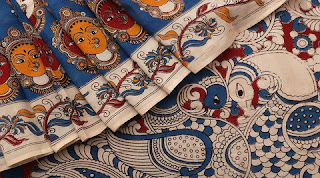TOP10 FABRICS IN OUR TEXTILE STORE IN NANDIGAMA
we sell all the fabrics but there are ten fabrics that are customer favourite..(based in india)
There are thousands of weaving patterns in India because of the country’s climate and biodiversity. Indian’s textile tradition has been shaped by many factors, such as the climate, geography, local cultural customs, and raw material availability among others. In India, the fabric is made from a variety of raw materials, including silk, cotton, jute, and wool. India’s weaving traditions are dominated by cotton and silk. Assam, Banaras, Murshidabad, Surat, Kanchipuram, and Patan are some of India’s major silk weaving centers. Let us look at some of the most famous fabrics in india.
1. Kalamkari:-Kalamkari is a 3000-year-old art, originated in Indian. Kalam means pen, and Kari means work, so it’s Pen-work. The Kalamkari artist uses a bamboo or date palm stick for the brush or pen with a bundle of fine hair attached to one end. However, these paintings are no longer just limited to canvas. They can be seen on silk and other materials as well. A kalamkari is a form of art that combines printmaking and painting. Organic pigments were used in the creation of these artworks. Mordants such as iron, tin, copper, or alum are used to prepare most colors. This type of painting can be found in a variety of forms and styles throughout the Indian subcontinent.
2. Kancheepuram:-Craftsmen in Kanchi (Kanchipuram) near Bangalore, South India, have created a magnificent silk sari using Kanjeevaram silk, hence they are known as kanjeevaram silk. Kanjeevaram saree’s silk is extremely fine and durable, making it one of the most popular silks around the globe. For a South Indian woman, it is essential to have a kanjeevaram saree in her closet, as it the considered as their traditional outfit. Kanjeevaram silk sarees from India have a staggering variety of textur;es, colors, and designs. These sarees can be made in 10-12 days if they are simple.
3. Apatani:-Originally from Arunachal Pradesh, the Apatani weave is named after the Apatani tribe. In Arunachal Pradesh, this tribe’s weaving techniques are far more advanced than the rest of the tribes. Weaved fabrics from Apatani are known for their geometric patterns, primarily regular designs and zigzag patterns, which can be seen on the fabric. Many people consider it an essential part of their wardrobe.
4. Muga Silk:-India’s golden yellow silk, known as Muga, is the pride of Assam state. Antheraea assamensis, a semi-domesticated multivoltine silkworm, is used to produce it. Som and Soalu silkworms feed on the aromatic leaves and are reared on Tasar-like trees. Accordingly, the Muga culture is unique to the state of Assam and is a vital part of the state’s tradition and culture. Sarees, mekhalas, chaddars, etc., are made from Muga silk, a high-end product.
5. Patola Silk:-Gujarat is known for its Patola silk saris, which are the pride of Gujarat. The resist dyeing technique was used to create these saris. As far as Patola saris are concerned, there are two types. Unlike the Patan patola, the Rajkot patola is only vertically resist-dyed (single ikat) (double ikat). Before weaving, the yarn is resist-dyed. In India, patola saris are well-known for their vibrant colors and geometric patterns interspersed with folk motifs. Due to the twill weave, the zari of the sari has a muted sheen. Intensely colored diagonal borders mimic the effect of gold enameling on the surface. For more casual occasions, Aashavali saris don’t have such spectacular use.





Comments
Post a Comment